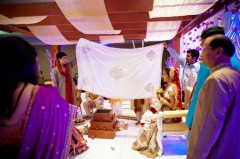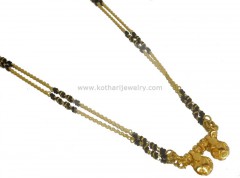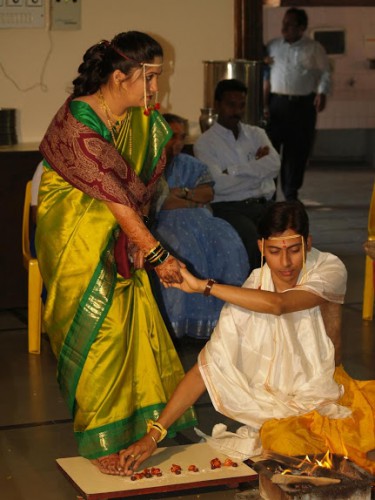04/20/2014
The Indian wedding for Dummies - 4. Rites and ceremonies
The "Indian wedding" (I should say the Hindu wedding to be exact) has made the subject of numerous books, movies, visits to India. In short it’s an institution. I will try here to understand something to it!
So here is how it goes – in broad lines and in general (as there are significant differences according to regions and castes).
1. The talking and the seeds
The groom must begin by making a vow of sainthood (brahmacharya) and refusing the marriage. The father of the bride must then convince him to give up this idea and to marry his daughter.
The said daughter sews then 9 seeds in earthen pots in time for them to have germinated on the D day; this is the symbol of fertility in marriage. Simultaneously she invokes the goddess Gowri Devi, an icon of the ideal woman.
2. The Tilak ceremony
Traditionally, the father and other males of the bride’s family go to the guy’s house and, so as to seal the deal, they apply a dot of vermilion paste on his forehead (tilak) then offer him some gifts. In return, he will send presents to his future in-laws.
3. Betrothal and sagai
During the betrothal/engagement ceremony, gold rings are exchanged.
During sagai, sometimes performed along with the engagement, the mother-in-law offers jewelry, clothes, make-up and baby toys. It is the time of setting the wedding date.
4. Sangeet (traditionally a North-Indian custom)
The women on the bride’s side gather with music, dancing, gossiping and snacks.
5. Pitthiand Mehndi
The woman (and also the man if he wants to) is covered with a paste of turmeric, chick-pea flour and water or oil, in order to be purified and have a beautiful skin on the D day.
Follows the henna painting on the hands and feet (mehndi). According to some belief, the darker the henna the more the husband will love his wife; and according to the tradition, the woman should not step out of the house after the mehndi is applied and only resume housework once it has faded.
6. The arrival of the spouses
 The groom must arrive with great fanfare (baraat), on a horse or an elephant or in a car luxury, to the sound of drums and trumpets, with a procession of relatives dancing. Upon arrival, the mother-in-law receives him by putting a tilak on his forehead, waving a tray with fire under his nose to chase the evil spirits away and then he takes place on stage where he waits for the bride. When she arrives, she tries to pass a garland of flowers around his neck (I say try because the groom’s friends, to tease her, prevent her from doing it for some time). Finally he has a garland, and he returns the favor to her and everything can start. This doesn’t fit in too much with the sheet story below but well...
The groom must arrive with great fanfare (baraat), on a horse or an elephant or in a car luxury, to the sound of drums and trumpets, with a procession of relatives dancing. Upon arrival, the mother-in-law receives him by putting a tilak on his forehead, waving a tray with fire under his nose to chase the evil spirits away and then he takes place on stage where he waits for the bride. When she arrives, she tries to pass a garland of flowers around his neck (I say try because the groom’s friends, to tease her, prevent her from doing it for some time). Finally he has a garland, and he returns the favor to her and everything can start. This doesn’t fit in too much with the sheet story below but well...
7. Mandap, or the marriage itself
We arrive finally at the point where the priest will perform his rituals. Are present on the stage the bride, the groom and their parents. The other guests are free to attend but usually enjoy their time, talking and eating.
To be short, during the mandap, here is what happens: after a prayer for Ganesh, the groom is regarded as an incarnation of the God Vishnu and worshipped as such. The bride, adorned with gold, is offered by the father as a wife to Vishnu. The hands of the spouses are joined to symbolize the union but they are still separated by a bed sheet and can not see each other. Over the cloth, they place on the top of each other’s head a paste made from cumin seeds and jaggery (dough having with a positive energy) and the curtain falls!
The groom then tie a rope made of grass around the waist of his bride, to support her in her new responsibilities (apparently Hindus are used to tie a rope around their waist to protect their spine in the effort). He will untie it at the end of the mandap.
 He passes around her neck a necklace with two pendants in gold (Mangalya), one given by the father and the other by the father-in-law. This sacred necklace represents the commitment, protection and security offered by the groom. He ties the necklace with three knots. Then the scarves of the spouses are knotted together, symbol of the eternal bond.
He passes around her neck a necklace with two pendants in gold (Mangalya), one given by the father and the other by the father-in-law. This sacred necklace represents the commitment, protection and security offered by the groom. He ties the necklace with three knots. Then the scarves of the spouses are knotted together, symbol of the eternal bond.
A bit of fun then: the bride and groom spread on each other rice mixed with saffron and turmeric, before Homam, the ceremony of the Holy Fire: seven small rounds around the fire.
Finally, the groom takes his wife’s left foot and places it on a stone (“be as strong as this stone and don't let the tribulations of life take you down”) and passes silver rings (mettelu) on her toes. They look at the stars together while being reminded that they must lead a life as stable as the stars.
They break the fast by feeding each other. And ghee (some kind of fat) is offered to feed the fire.
There are a lot of other customs, sometimes very funny: when the bride’s family steal the groom’s shoes and he has to bargain to buy them back, when the bride’s brother twists the ears of his brother-in-law to guard him against bad behavior or has to wash the groom’s feet, the fact that after walking around the fire bride has the right to sit on the left of her husband, closer to his heart, or the exchange of coconuts (symbol of fertility) between married couple in some communities etc.
Throughout the wedding there are obviously many buffets (with or without alcoholic, depending on the religion, caste, families) and dances! But there again, it also depends on the region. The “Bollywood weddings” are mostly performed in the North (Punjab) while people in the South (especially in Kerala) are less lavish, less loud, simpler (the important thing is to eat well!)…
Sources: http://suravajhala.hubpages.com/hub/Hindu-marriage-secret... ;http://www.culturalindia.NET/weddings/wedding-rituals/; http://www.thecultureist.com/2013/05/31/vivaah-traditional-Indian-wedding-ceremony-rituals/
08:00 Posted in Incredible India!, Why in India... | Permalink | Comments (0) | Tags: india, marriage, wedding, arranged marriage, forced marriage, love marriage, rites, ceremonies, rituals, divorce, sheet, mehndi, henna, baraat, sex, incompatibility, contract, classifieds, matrimonials, matchmaker, nayan, astrologers, horoscope, marry a tree, marry a pot, auspicious, date, joint family, kama sutra | ![]() Facebook | |
Facebook | |
















The comments are closed.